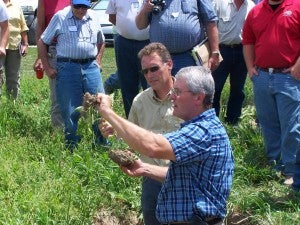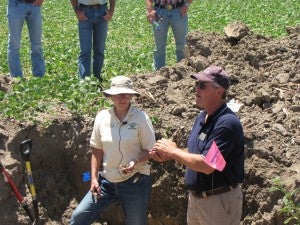Everyone agrees that no-till farming should be used in conjunction with other practices to maximize soil health – but in reality, “no-till” means different things to different people across the agricultural world.
To clarify what exactly is involved in no-till farming, a key topic of discussion at this week’s Soil Health Partnership (SHP) summit in St. Louis, I asked one of Indiana’s leading tillage experts, Barry Fisher, an agronomist and soil health specialist with the Natural Resources Conservation Service (NRCS).
How do you define no-till farming?
NRCS defines no-till farming as limiting soil disturbance to manage the amount and distribution of crop and plant residue on the soil surface year round. In other words, no-till is just planting directly into the previous year’s crop residues, without any tillage having occurred. But this is just for any given year – and we’re trying to focus on quality no-till systems that take multiple years into account, since no-till farming works best if it is implemented on a continuous basis and combined with other conservation practices such as cover crops and nutrient management.
What practices do you consider “no-till”?
True no-till means you don’t till the soil at all, even between crops. Strip tillage – where soil disturbance occurs on 30 percent or less of the field – also qualifies as no-till. However, most farmers in the Midwest practice rotational tillage, which involves tilling every other year and alternating between a no-till soybean and a tilled corn system. This is what separates quality no-till from the common term “conservation tillage,” which may involve more disturbance to the soil surface.
What are the benefits of no-till?
By leaving the surface covered with the previous crop’s residues, you can reduce erosion and runoff, protect your field from rain impacts and extreme summer temperatures, maintain or increase soil quality and organic matter content, and reduce energy use.
Increased organic matter is especially important, since for every 1 percent of organic matter you can build into the topsoil, you build a bank account of about 1,000 pounds of nitrogen and 100 pounds of phosphorous in the soil’s reserve, per acre. This means that nutrient-use efficiency is improved and, since the soil becomes nutrient-rich, less fertilizer may be required based on adaptive management measures.
No-till also means that your soil starts to act as a sponge instead of a deflector of water; this in turn increases the resiliency and productivity of the soil. Healthy soils also have greater water holding capacity, so they can store more water longer into the season and help to replenish aquifers.
Input costs are also lowered with no-till, since the equipment requires less horsepower. There is also a time-saving benefit since tilling requires multiple passes across a field, whereas with no-till, you can plant your crop with just one trip across the field.
What are the barriers to adopting no-till across the Midwest?
The reasons farmers have yet to broadly adopt true no-till systems are varied. For example, farmers have a long-standing tradition of tilling the soil. Transitioning to no-till is seen as a risk since equipment modifications are required. And they often receive mixed messages about the economic benefits.
These farmers’ experiences point to a critical fact that no-till by itself may not be enough to ensure success, but by incorporating adaptive nutrient management techniques and cover crops to the system, the cropping system is jump-started, soil health improves, and the economic benefits come much sooner.
How are you working to get more farmers on board with no-till?
It’s hard to fully understand the benefits of no-till until you’ve been down into a soil pit and seen the results first-hand.
Fortunately, the farmers who have embraced no-till are tremendous advocates for this system. Many farmers using no-till practices are helping train NRCS employees and other conservation professionals here in Indiana on the practice, and speaking at conferences to talk about the benefits they’ve experienced. Indiana’s Conservation Cropping Systems Initiative (CCSI) website also has information on upcoming workshops to help farmers get started.











